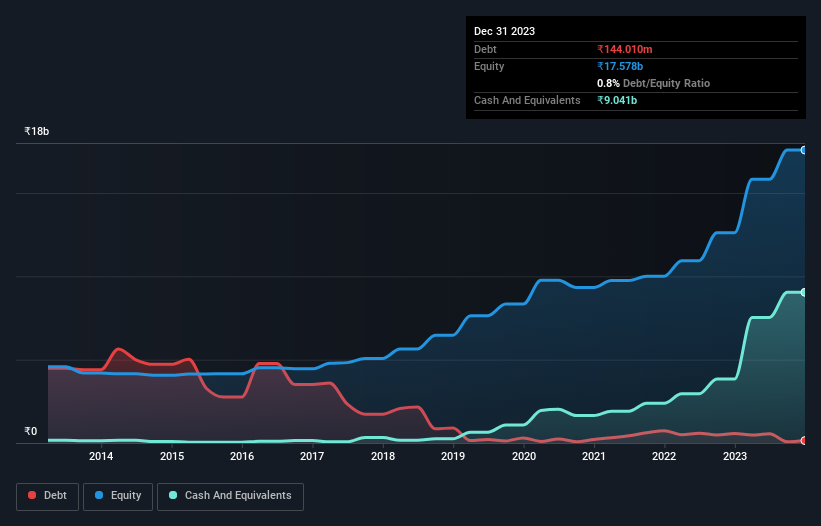- India
- /
- Paper and Forestry Products
- /
- NSEI:ANDHRAPAP
Andhra Paper (NSE:ANDHRAPAP) Seems To Use Debt Rather Sparingly
Warren Buffett famously said, 'Volatility is far from synonymous with risk.' It's only natural to consider a company's balance sheet when you examine how risky it is, since debt is often involved when a business collapses. We can see that Andhra Paper Limited (NSE:ANDHRAPAP) does use debt in its business. But is this debt a concern to shareholders?
Why Does Debt Bring Risk?
Debt is a tool to help businesses grow, but if a business is incapable of paying off its lenders, then it exists at their mercy. In the worst case scenario, a company can go bankrupt if it cannot pay its creditors. However, a more common (but still painful) scenario is that it has to raise new equity capital at a low price, thus permanently diluting shareholders. By replacing dilution, though, debt can be an extremely good tool for businesses that need capital to invest in growth at high rates of return. The first step when considering a company's debt levels is to consider its cash and debt together.
See our latest analysis for Andhra Paper
How Much Debt Does Andhra Paper Carry?
You can click the graphic below for the historical numbers, but it shows that Andhra Paper had ₹144.0m of debt in September 2023, down from ₹569.9m, one year before. However, its balance sheet shows it holds ₹9.04b in cash, so it actually has ₹8.90b net cash.

How Healthy Is Andhra Paper's Balance Sheet?
Zooming in on the latest balance sheet data, we can see that Andhra Paper had liabilities of ₹3.75b due within 12 months and liabilities of ₹859.6m due beyond that. Offsetting these obligations, it had cash of ₹9.04b as well as receivables valued at ₹1.38b due within 12 months. So it can boast ₹5.81b more liquid assets than total liabilities.
This excess liquidity suggests that Andhra Paper is taking a careful approach to debt. Due to its strong net asset position, it is not likely to face issues with its lenders. Succinctly put, Andhra Paper boasts net cash, so it's fair to say it does not have a heavy debt load!
The good news is that Andhra Paper has increased its EBIT by 7.2% over twelve months, which should ease any concerns about debt repayment. There's no doubt that we learn most about debt from the balance sheet. But you can't view debt in total isolation; since Andhra Paper will need earnings to service that debt. So if you're keen to discover more about its earnings, it might be worth checking out this graph of its long term earnings trend.
Finally, a company can only pay off debt with cold hard cash, not accounting profits. Andhra Paper may have net cash on the balance sheet, but it is still interesting to look at how well the business converts its earnings before interest and tax (EBIT) to free cash flow, because that will influence both its need for, and its capacity to manage debt. During the last three years, Andhra Paper generated free cash flow amounting to a very robust 83% of its EBIT, more than we'd expect. That puts it in a very strong position to pay down debt.
Summing Up
While it is always sensible to investigate a company's debt, in this case Andhra Paper has ₹8.90b in net cash and a decent-looking balance sheet. And it impressed us with free cash flow of ₹4.7b, being 83% of its EBIT. So is Andhra Paper's debt a risk? It doesn't seem so to us. When analysing debt levels, the balance sheet is the obvious place to start. However, not all investment risk resides within the balance sheet - far from it. For instance, we've identified 1 warning sign for Andhra Paper that you should be aware of.
When all is said and done, sometimes its easier to focus on companies that don't even need debt. Readers can access a list of growth stocks with zero net debt 100% free, right now.
New: Manage All Your Stock Portfolios in One Place
We've created the ultimate portfolio companion for stock investors, and it's free.
• Connect an unlimited number of Portfolios and see your total in one currency
• Be alerted to new Warning Signs or Risks via email or mobile
• Track the Fair Value of your stocks
Have feedback on this article? Concerned about the content? Get in touch with us directly. Alternatively, email editorial-team (at) simplywallst.com.
This article by Simply Wall St is general in nature. We provide commentary based on historical data and analyst forecasts only using an unbiased methodology and our articles are not intended to be financial advice. It does not constitute a recommendation to buy or sell any stock, and does not take account of your objectives, or your financial situation. We aim to bring you long-term focused analysis driven by fundamental data. Note that our analysis may not factor in the latest price-sensitive company announcements or qualitative material. Simply Wall St has no position in any stocks mentioned.
About NSEI:ANDHRAPAP
Andhra Paper
Manufactures and sells paper, paperboard, and pulp in India and internationally.
Mediocre balance sheet second-rate dividend payer.
Market Insights
Community Narratives


Recently Updated Narratives


Engineered for Stability. Positioned for Growth.


MINISO's fair value is projected at 26.69 with an anticipated PE ratio shift of 20x


Fiverr International will transform the freelance industry with AI-powered growth
Popular Narratives


MicroVision will explode future revenue by 380.37% with a vision towards success


NVDA: Expanding AI Demand Will Drive Major Data Center Investments Through 2026



